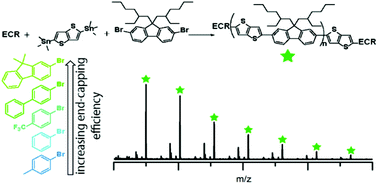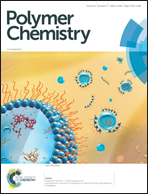A one-pot strategy to improve end-capping efficacy in Stille poly-condensations†
Abstract
Herein we examine the end-capping efficacy of several end-capping reagents (ECRs) in the Stille polymerization of 2,7-dibromo-9,9-bis(2-ethylhexyl)fluorene (Fl) and 2,5-bis(trimethylstannyl)-thieno[3,2-b]thiophene (TT). Polymerizations were carried out in a one-pot fashion where the molar ratio of TT relative to Fl was biased, ideally generating bis(trimethylstannyl) macromolecules. Various ECRs (bromobenzene, 4-bromotoluene, 4-(trifluoromethyl) bromobenzene, 4,4′-bromobiphenyl, 2-bromo-9,9-dimethylfluorene, iodobenzene, 4-iodotoluene, and 4,4′-iodobiphenyl) differing in reactivity were employed in the one-pot reaction. Polymers were characterized using GPC, 1H NMR, and end-capping efficacy was evaluated with MALDI-ToF MS. The iodo derivatives were found to disrupt propagation, severely inhibiting molecular weight. The bromo ECRs varied in end-capping efficiency: bromofluorene ∼ bromobiphenyl > trifluoromethylbromobenzene ∼ bromobenzene > bromotoluene. Additionally, we demonstrate a strong efficiency dependence on initial monomer concentration and demonstrate this method's superiority over post-polymerization end-capping.



 Please wait while we load your content...
Please wait while we load your content...